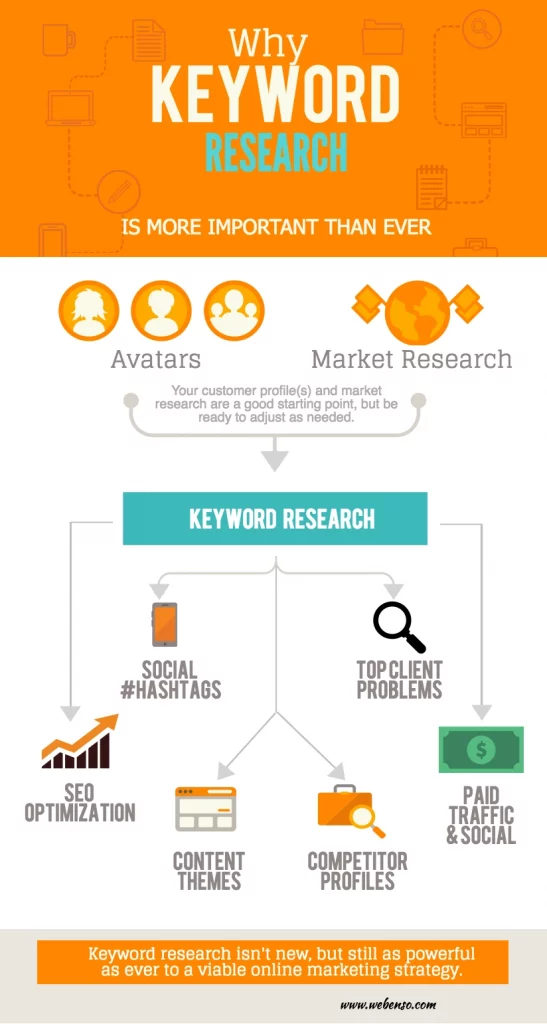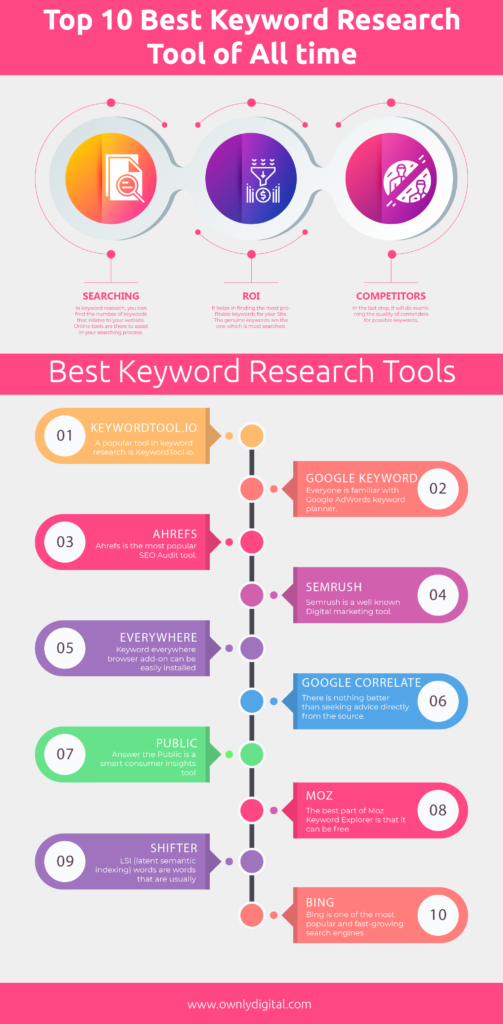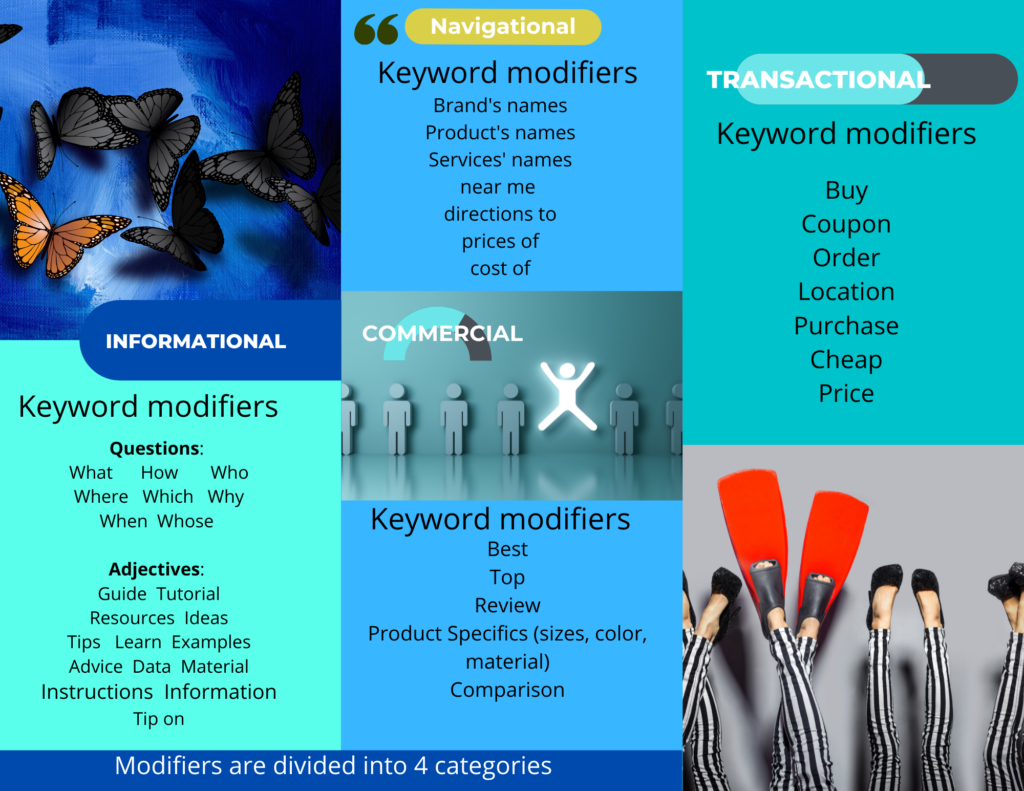Are keywords Still Useful?
The “keywords” is a much-debated term in the networks. Many users say that it is beneficial for SEO; however, others say it is no longer valuable. One way or another, it is crucial that you know what it is and what it is used for. These articles will give you a vast understanding of the significance of keywords and why you should use them.
Keywords continue to play an important part in SEO and are still effective for a variety of reasons. Here’s proof of their significance:
Relevance to Search Engines: Keywords serve as signals to search engines, showing the material and subjects addressed on a site. By carefully inserting relevant keywords into your content, you enhance the likelihood that search engines will recognize your material as relevant to user search queries. This increases the visibility and ranking of your website in search engine results.
Keywords allow you to fit your content with the search queries and interests of your target audience. You may produce content that fulfills their requirements and draws people to your website by identifying the keywords and phrases they use when looking for information, goods, or services connected to your sector. Using the proper keywords to generate quality visitors to your site may increase the chance of conversions and engagement.
Content Optimization: Using keywords correctly in your website’s content, meta tags, headers, and other aspects aids in optimizing your content for search engines. By adhering to SEO best practices and organically including keywords, you improve the visibility and crawlability of your web pages, making it simpler for search engines to index and retrieve important content.
Competitive Advantage: By doing keyword research, you may uncover terms with high search traffic yet low competition. Targeting less competitive keywords, often known as long-tail keywords, increases your chances of ranking higher and attracting targeted visitors. This might give you an edge over bigger rivals who may concentrate on more generic or competitive terms.
While keywords are still vital, they must be used strategically and meaningfully. Keyword stuffing, or the artificial use of terms, may result in penalties from search engines and impair your website’s results. Instead, concentrate on producing high-quality, meaningful content that answers user intent and combines important keywords organically.
Finally, keywords continue to be an important component of SEO, assisting search engines in understanding the content of your web pages and attracting your target audience. You may boost your website’s exposure, attract more organic visitors, and raise your chances of reaching and engaging your chosen audience by performing keyword research, optimizing your content, and targeting relevant keywords.
Lorem ipsum dolor sit amet, consectetur adipiscing elit. Ut elit tellus, luctus nec ullamcorper mattis, pulvinar dapibus leo.
Keywords as a method to increase your audience
Using keywords carefully may be an effective way to expand your audience and bring more traffic to your website. Here is a confirmation and explanation on the significance of keywords:
Higher CTRs: By selecting relevant keywords and improving your content, you increase your chances of appearing on the first page of search engine results. Being visible on the first page, particularly towards the top, enhances the possibility that consumers will click on your title, leading in increased click-through rates. Visibility in search rankings builds reputation and draws more organic visitors.
Improved Visibility and Organic Traffic: When your website ranks better in search engine results, it reaches a wider audience. Users are more inclined to click on websites that appear towards the top of search results, resulting in more organic traffic. Effective keyword use assists search engines in determining the relevancy of your material and indexing it correctly, making it more discoverable to prospective users.
Targeting a Specific Audience: By utilizing relevant keywords that correspond to the search queries of your target audience, you may attract more qualified and interested visitors to your website. Keywords enable you to target certain demographics, geographic regions, or hobbies, ensuring that your material is found by the proper audience. This may result in increased engagement, conversions, and company development.
Competitive advantage: may be gained by doing extensive keyword research and applying efficient keyword optimization tactics. By choosing specialized or less competitive keywords, you may tap into market groups that your rivals may have neglected. Long-tail keywords and keyword variants may help you attract a more specialized audience and obtain higher ranks in those particular search searches.
Keyword Intent as a guide for making content
The underlying meaning or purpose behind a user’s search query is referred to as keyword intent. It understands that various search words are used to represent varied information demands, and search engines strive to grasp the user’s intent in order to give the most relevant results. Understanding keyword intent allows content producers to connect their material with what people are seeking for, ensuring that their content successfully serves their demands.
When you produce content based on keyword intent, you can more effectively connect with your target audience and boost the odds of engagement and conversion. Here’s how keyword intent may help you create content:
Informative Intention: Some users want information or answers to their questions. Creating material that gives useful information, answers frequently asked questions, or provides complete instructions may attract and engage readers looking for information. This form of material establishes your brand as a valuable resource and fosters trust among your target audience.
Users that have commercial purpose are in the research or assessment stage of their purchase cycle. They want product comparisons, reviews, or price information. Content focusing on product features, advantages, and comparisons may successfully engage consumers with commercial purpose, assisting them in making educated choices and perhaps resulting to conversions.
Users with navigational purpose are searching for particular websites or resources. They have already decided on a brand or website. Creating content that focuses on your brand, goods, or services may pique the interest of visitors with navigational purpose, strengthening your brand presence and driving them to relevant pages on your website.
Understanding and addressing the various forms of keyword intent allows you to create content that speaks to the requirements of your audience, enhances organic exposure, and boosts the possibility of conversion. Thorough keyword research and analysis may reveal the reasoning behind certain search inquiries, allowing you to design content that successfully addresses those requirements and drives desired actions.
How to Research for Valuable Keywords?
The valuable keyword selection process is vital to obtaining a high SEO ranking. It is the best way for search engines to get content more aligned with user searches. Therefore, choosing valuable keywords helps increase traffic to your page and improve your company’s position.
Learn a bit every day, come and read!
How does Keyword Research Affect Your Business?
Keyword search refers to the terms people write on search engines to discover and examine something. The main idea when using keyword search is to find specific data. Keyword search is closely related to search engine optimization (SEO) ranking and marketing. The concept of keyword search is to produce query results, query popularity, and ranking complexity.
How to finding Valuable keywords for new sites?
It can be hard to find good keywords if you are new to keyword search, but these tips will help you get started:
Look at the keywords your rivals use and where they stand in your market. Find out what terms they are using that are working well and think about adding those that are relevant to your own keyword strategy. This can give you information about buzzwords that are important in your business.
Long-Tail Keywords: Concentrate on long-tail keywords, which are typically more specific and less competitive. Long-tail keywords target a smaller audience, but their conversion rates are typically higher. Utilize keyword research tools to identify relevant long-tail keywords for your niche or industry.
Include location-based keywords to target local consumers if your new website serves a specific location or region. This can assist in attracting users searching for products or services in your area.
Use tools for keyword research Use keyword study tools like Google Keyword Planner, SEMrush, Ahrefs, Moz Keyword Explorer, or Ubersuggest to find new terms to use. These tools give you information about the number of searches, phrase ideas, and the amount of competition, which can help you find good keywords for your new website.
Concentrate on Keywords with Low Competition: As a new website, it may be difficult to compete with established sites for highly competitive keywords. Prioritize instead keywords with less competition and reasonable search volume. This enables you to progressively increase your authority and visibility while attracting targeted traffic.
Consider User Intent: Think about the intent behind the keywords you’re targeting. Select keywords that correlate with your website’s purpose and the solutions or information you offer. Understanding user intent will help you attract site visitors who are more likely to become engaged.
Utilize Long-Form Content: Developing comprehensive, in-depth content on specific topics can assist your new website in gaining visibility and attracting organic traffic. Long-form content affords the opportunity to incorporate valuable keywords naturally and effectively address users’ queries or requirements.
Use web tracking tools like Google tracking to keep an eye on how your site is doing and make any changes that are needed. You can find good keywords that work well for your site by keeping an eye on the keywords that drive traffic and sales. Change your keyword approach based on what you’ve learned here.
Remember that establishing organic visibility and positioning for valuable keywords requires time and effort. Continuously evaluate and improve your keyword strategy as your website acquires authority in its niche.

How to choose the best keywords?
Finding a balance between search volume, relevance to your business or content, and competition is required when selecting the best keywords. Here is a step-by-step guide for selecting the most effective keywords:
Specify Your Objectives: Identify the objectives of your SEO strategy. Are you looking to increase conversions, drive more organic traffic, or target a specific audience? Understanding your objectives will guide the selection of your keywords.
Gain a comprehensive understanding of your target audience’s demographics, interests, and search behavior. Consider the terminology they use, the queries they pose, and the specific search terms they might use to find products or information related to your business.
Utilize keyword research tools such as Google Keyword Planner, SEMrush, Ahrefs, or Moz Keyword Explorer to discover keyword ideas and collect data on search volume, keyword difficulty, and related keywords. Start with broad industry-related terms, then expand to more specific long-tail keywords.
Analyze Search Volume: Identify keywords with a healthy search volume that aligns with your objectives and target audience. Higher search volumes typically indicate greater demand, but be wary of keywords with high competition, as they may be more difficult to rank for.
Ensure that the keywords you choose are highly relevant to your business, products, or content. Consider the intent behind each keyword and whether or not it corresponds to the services or information you provide. Focus on keywords that align with your target audience’s requirements and search queries.
Analyze Keyword Competition: Assess the keyword competition or difficulty score provided by keyword research tools. High-competition keywords may be more difficult to rank for, particularly if your website is new or small. By balancing competition and relevance, you can select keywords that provide a favorable opportunity for visibility and ranking.
Consider Long-Tail Keywords Long-tail keywords are more specific and typically have lower search volumes. Still, they can be useful for targeting a specific audience and attracting more qualified traffic. Include pertinent long-tail keywords in your strategy to attract users with specific goals.
Analyze Competitor Keywords: Analyze your competitors’ keywords in their content and SEO strategies. Identify the keywords that your competitors are effectively ranking for and consider incorporating those that are pertinent into your list. This can help you maintain a competitive edge and identify lucrative keyword opportunities.
Refine and Monitor: Based on the aforementioned factors, refine your keyword list to include a mixture of high-volume, medium-volume, and long-tail keywords. Regularly monitor and evaluate the performance of your keywords, making any necessary adjustments based on changes in search trends, user behavior, or business objectives.
Remember that keyword selection is an ongoing process. Continually optimize your keyword strategy for the best results by keeping up with keyword trends and monitoring your website’s performance.

How to check for Keywords search demand
Utilize Keyword Research Tools There are a variety of keyword research tools available that can provide information on search volume and keyword data. Popular instruments include:
Google Keyword Planner: This tool, part of Google Ads, allows you to explore keyword ideas and get search volume estimates based on historical data.
SEMrush: SEMrush provides keyword analytics, search volume, keyword difficulty, and related keyword suggestions. It also offers competitor analysis and other valuable SEO metrics.
Ahrefs: Ahrefs offers a comprehensive suite of SEO tools, including keyword research. It provides search volume, keyword difficulty, and competitive analysis to help you find valuable keywords.
Moz Keyword Explorer: Moz’s tool provides search volume data, organic click-through rates, keyword difficulty, and other metrics to assist in keyword research.
Enter Your Seed Keywords: Start by entering your seed keywords or topics related to your industry or niche into the keyword research tool of your choice. These tools will generate a list of keyword ideas and their associated search volumes.
Analyze Search Volume: Review the search volume data provided by the keyword research tool. Look for keywords with higher search volumes, as they indicate higher demand from users.
Consider Keyword Relevance: Keywords with a high search volume are essential, but it’s equally important to consider keyword relevance to your business or content. Consider keywords that correspond to your target audience and the topics for which you wish to rank.
Explore Long-Tail Keywords: Long-tail keywords are more specific and have lower search volumes, but they can be useful for targeting a specific audience and attracting more qualified traffic. Pay close attention to moderately popular long-tail keywords that are highly relevant to your content.
Assess Keyword Competition: Many keyword research tools also provide information on keyword difficulty or competition. Consider the level of competition for a keyword before deciding to target it. High-competition keywords may be more challenging to rank for, especially if your website or content is relatively new.
Refine Your Keyword List: Based on an analysis of search volume, relevance, and competition, refine your keyword list to include the most beneficial keywords for your content strategy.
How to Make your User Driven Content Strategy a Success
Understanding search intent is the key to making your user-driven content strategy stand out. Often the problem is not that the content could be of better quality. On the contrary, there is very engaging content with valuable information. However, the SEO rank needs to be at the desired level. The reason is that the valuable content is not aligned with the users’ intention. That is, the content goes in a different direction than the search intention of its users.
This guide will help you understand the process of search intent and how to tie them harmoniously and accurately to your content so that both concepts help you achieve a high-performance SEO ranking.
Don’t Give Up! Learn More Here

Where to Use the Keywords
Keywords on your SEO Title Tag (Meta Title Tag) and Meta Description
The SEO title tag acts as a brief summary of the content and is the title that displays on search engine result pages (SERPs). To increase search engine exposure and draw visitors’ interest, it is crucial to enhance the SEO title tag using relevant keywords. To ensure that the SEO title tag shows correctly on all platforms, it is advised to keep it within the character restriction of 50 to 60 characters.
Contrarily, the meta description is a succinct overview of the material that shows on SERPs underneath the SEO title tag. Although it has no direct effect on search engine results, the meta description is very important for getting visitors to click on your website. By using seed keywords in the meta description, you may increase the relevance of your website in search results by helping Google comprehend the content of your page. You must create an engaging and useful meta-description that appropriately summarizes the content to get readers to go on to your website.
Consider the term “meta description” as an example. In this situation, you might include the term in both the meta description and the SEO title tag. For instance, the meta description for the SEO title tag might read “Learn how to optimize your meta description for better search results and increased click-through rates,” and the meta title tag could read “Mastering Meta Description Techniques | YourWebsite.com.” Learn how to improve the visibility of your website and increase visitors.
You may increase the visibility of your website in search results and increase the probability of getting clicks from visitors who find the description captivating and relevant to their search intent by using seed keywords in the SEO title tag and meta description.
In conclusion, adding relevant keywords to the SEO title tag and meta description may raise your website’s visibility in search results, grab consumers’ attention, and increase website click-throughs. Making sure your SEO titles and meta descriptions are clear, detailed, and keyword-rich can help you convince readers and search engines alike of the importance of your material.

Use Keywords in Your Article Title and Sections
Indeed, including keywords in the title of your post is a good idea as long as they make sense in relation to the message and provide a precise description of the content. The inclusion of pertinent keywords in the title aids search engines like Google in comprehending the subject and setting of your post, which may improve your position in search results.
Furthermore, it’s advantageous to use the main keyword in the first few lines or paragraphs of your text. This positioning may raise your rating for related queries by indicating to search engines that your material is relevant to the term. Additionally, it is advised to use synonyms for the main term throughout the remaining text. By using these variants, you may improve how search engines understand your content and how it compares to that of your rivals.
In order to maintain a perfect structure, the principal keywords must be thoughtfully included into crucial components like meta title tags, meta descriptions, and throughout the text itself. Meta title tags and meta descriptions are HTML components that provide search engine users succinct summaries of your web pages. These components’ relevancy and exposure in search results may be improved by include the main keywords, which will also increase clickthrough rates and boost your SEO performance as a whole.
The use of keywords is crucial, but it must always be done in a natural and relevant fashion, it is vital to remember. Overusing keywords or “stuffing” them into text in an unnatural way may detract from the user experience and possibly result in penalties from search engines. Long-term SEO performance depends on striking a balance between keyword optimization and high-quality, compelling, and well-structured content.
In conclusion, using keywords efficiently in the article title, first few sentences, and throughout the content, including meta tags, may help the page rank and increase search engine exposure. Your articles’ SEO foundation is solid if you strike the correct mix between keyword optimization and user-focused content.
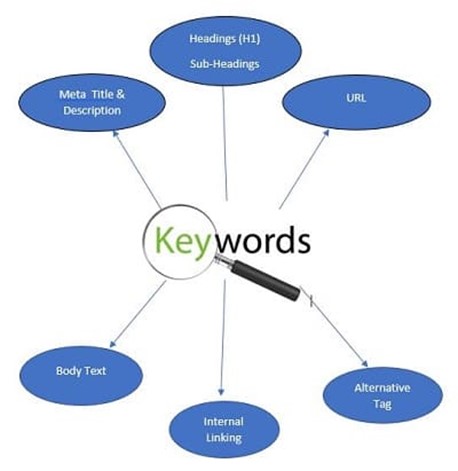
Add Keywords in Image Alt-tags
Using graphics in your content may significantly improve user comprehension and engagement. It’s crucial to optimize the usage of photos, however, by including relevant keywords in the alt tags. An image’s content may be described in text form using alt tags or attributes. This not only benefits screen reader-dependent individuals with visual impairments but also helps search engine crawlers comprehend the relevance and context of the picture.
By include pertinent keywords in the alt tags, you provide search engines more information about the subject and substance of your site. This may enhance the visibility of your website in image search results and have a good effect on your SEO ranking.
Additionally, when an image cannot be loaded or when a user hovers over an image, alt attributes are shown. Even if consumers are unable to see the picture, this may nevertheless provide them essential information about the image’s content. By providing context and guaranteeing accessibility for all users, descriptive alt characteristics improve user experience.
However, avoiding employing alt tags or using generic ones that don’t accurately explain the content of the picture might hurt your SEO ranking and user experience. If the picture doesn’t load or can’t be seen, search engines could not completely comprehend the context of the image, and consumers might lose out on important details.
In conclusion, optimizing photos using detailed alt tags that include pertinent keywords enhances both user experience and search engine optimization. Even when the picture is not visible, it allows search engines to comprehend and rank your content more effectively while giving consumers useful information.
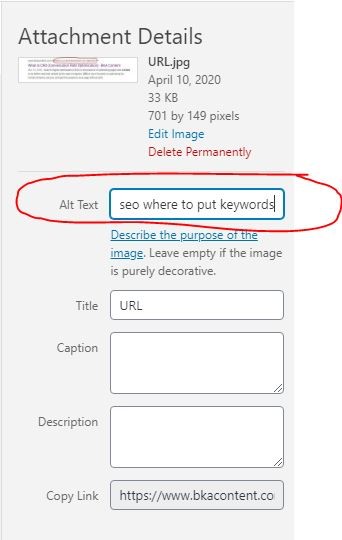
Use Keywords on your URLs, Links Anchor Text, and Social Media
It is true that include keywords in your URL may help both your audience and search engines like Google better comprehend your content. By include pertinent keywords in your URL structure, you may better communicate the theme or subject matter of your website and increase user discovery and comprehension.
Using keyword variants as part of your inbound anchor text strategy may help you diversify your link anchor text and prevent over-optimization. Your website’s overall SEO performance will increase if you use many keyword variants in your anchor text to inform search engines about the relevancy and context of the linked material.
Utilizing keywords in your social media accounts and posts may also help to increase traffic to your page and improve your SEO ranking. Your chances of getting found by visitors looking for similar subjects rise when you optimize your social media post using relevant keywords. Engaging social media postings may enhance exposure and possible referral traffic to your website by attracting more clicks, shares, and conversations.
Overall SEO efforts may be improved by using keywords in your URL, anchor text, and social media material. It helps diversify inbound anchor text, increase the clarity and relevancy of your content, and increase traffic from social media sites. You may improve your online presence and raise your SEO ranking by carefully integrating keywords into these components.
Seed Keywords for SEO: the footing for effective content development
For most people, seed keywords are short-tail keywords with high volume and competitiveness. However, seed keywords are much more than just “keywords.” They are the footing for effective content development and high SEO ranking. In addition, those words are the most crucial point of reference for creating long-tail keywords, helping you design and mature opportunities and optimization.
Keep reading, knowledge gives you superpowers!
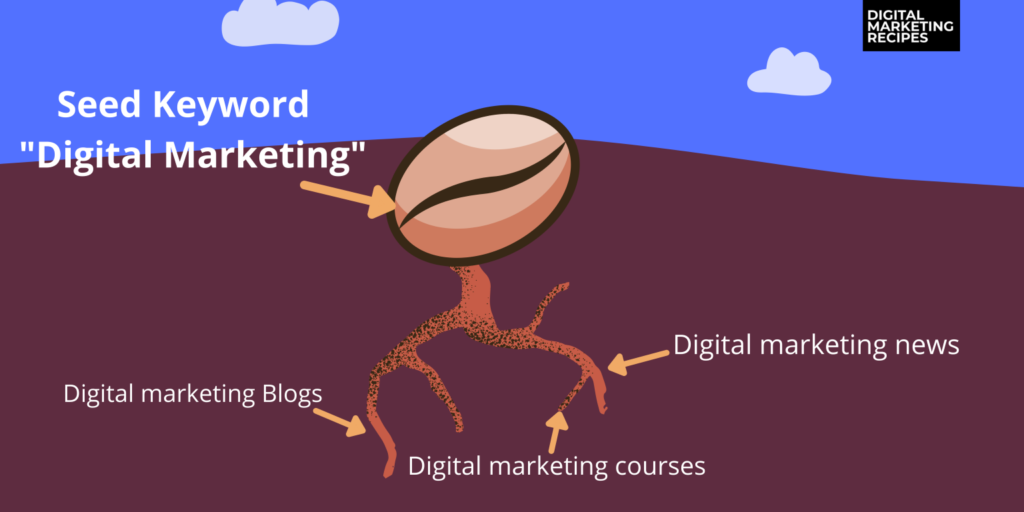
Keywords Type by Length and how to take advantage of them
The length helps you evaluate and choose the best keyword according to the search volume, potential traffic, and conversion rate.
You have three keywords alternative to select:
- Short-tail keywords (also known as the head, broad, or generic keywords)
- Mid-tail keywords
- Long-tail keywords
The image shows the level of difficulty in conversion based on the type of keyword length:
red color= high volume, and low conversion rate
lime green color= mid-volume and mid-conversion rate
aqua color= low volume and high conversion rate

Learn, learn, learn! Press to Learn!
What is the Difference between Keywords, Long-tail Keywords, and Search Terms?
Learn their differences and how to use them.
Modifiers to Enrich the Keywords
Words or statements that change the meaning of a sentence are called “modifiers.” They can be used to describe words, verbs, adjectives, and even other adverbs. Modifiers can be used to stress a point, make a sentence clearer, or make it more interesting.
Some types of common modifiers are:
Adjectives: Adjectives describe words and change how they are used. For instance, “the big dog” or “the beautiful flower.”
Adverbs: are words that describe how, when, where, or how much something happens. They change verbs, adjectives, and other adverbs. For instance, “she ran quickly” or “the house was very old.”
Prepositional phrases: They add more information to words or verbs, making them better. For example, “The dog was in the yard” or “She ran to the store.”
Participial words: change the meaning of names or verbs by giving more information about them. For example, “the dog was barking at the mailman” or “she ran laughing down the street.”
Adding a modifier to a sentence can make it more interesting and useful. They can also be used to bring attention to certain places or set a certain mood. For instance, “The dog ran quickly” could be changed to “The dog ran very quickly” to stress how fast the dog was running.
Modifiers are an important part of language, and you can use them to make your writing more clear and powerful. If you know how to use different modifiers, you can write more accurate and interesting lines.

